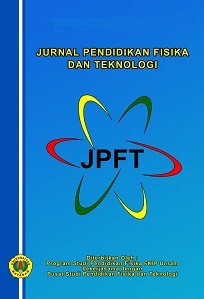The Effect of Mixed Dye Composition of Anthocyanin-Chlorophyll on DSSC Efficiency on TiO2/ZnO Semiconductors
DOI:
10.29303/jpft.v10i1.6192Published:
2024-06-15Issue:
Vol. 10 No. 1 (2024): January-JuneKeywords:
Efficiency, DSSC, TiO2/ZnOArticles
Downloads
How to Cite
Downloads
Metrics
Abstract
The effect of mixed dye composition of anthocyanin-chlorophyll on DSSC efficiency on TiO2/ZnO semiconductors aims to determine the effect of using dye containing anthocyanin-chlorophyll on the absorbance value and work efficiency value of Dye Sensitized Solar Cell (DSSC). The TiO2/ZnO was deposited using the doctor blade method and the dye was made using the maceration method. The counter electrode was made on FTO glass coated by calcined battery carbon with temperature in 450°C. The DSSC assembly was arranged in a sandwich shape. Then electrolyte is dripped in the middle of the DSSC layer. Characterization tests were carried out to determine the dye absorbance value and gap energy value using a UV-Vis spectrophotometer. DSSC efficiency testing uses current and voltage (I-V) characterization. DSSC testing was carried out using a multimeter with a light source from sunlight. The results of UV-Vis characterization showed that the highest absorbance value was obtained for the kale-mangosteen peel dye at a wavelength of 530 nm with an absorbance of 5.234%. The TiO2/ZnO gap energy obtained using the touch plot method is 2.42 eV. The highest efficiency value was obtained from the kale-mangosteen peel dye mixture of 0.0286%. There was an increase in the DSSC efficiency value when the dyes were combined.
References
Adu, R. E. Y., G. Gelyaman & M. Kabosu. (2022). Pemanfaatan Ekstrak Antosianin Dari Limbah Kulit Bawang Merah (Alium cepa) Sebagai Zat Pemeka (Sensitizer) Pada Dye Sensitized Sollar Cell (DSSC). ALCHEMY Jurnal Penelitian Kimia, 18(1), 103-111. DOI: https://doi.org/10.20961/alchemy.18.1.56104.103-111
Agus, S., D. Kurniawan & C. Cari. (2020). Pengaruh perbandingan komposisi ZnO dan TiO2 dalam Dye sensitized solar cell (DSSC) pada dye kangkung (impoema aquatica). Prosiding seminar nasional fisika dan aplikasinya.
Alfarisa, S., D. A. Rifai & P. L. Toruan. (2018). Studi difraksi sinar-x struktur nano seng oksida (ZnO). Risalah Fisika, 2(2), 53-57. DOI: https://doi.org/10.35895/rf.v2i2.114
Fistiani, M. D., F. Nurosyid & R. Suryana. (2017). Pengaruh komposisi campuran antosianin-klorofil sebagaai fotosensitizer terhadap efisiensi dye sensitized solar cell. Jurnal fisika dan aplikasinya, 13(1), 19-22. DOI: https://doi.org/10.12962/j24604682.v13i1.2132
Listari, N., & D. Agustini. 2018. Daun Pegagan (centella asiatica) dan kangkung (ipomea aquatica) sebagai fotosensitizer pada dye sensitized solar cell (DSSC). Jurnal Pendidikan Biologi dan Sains, 3(2).
Manurung, D. N., Nurhidayah & F. Deswardani. 2021. Pengaruh penggunaan dye tunggal dan dye campuran antosianin-klorofil terhadap efisiensi kerja dye sensitized solar cell (DSSC). Jurnal Pendidikan Fisika Tadulako Online, 9(1):83-88.
Maryani, D., Gunawan & Khabibi. (2012). Penentuan efisiensi DSSC (Dye Sensitized Solar Cell) yang dibuat dari semikonduktor ZnO yang diemban Fe3+ melalui metode presipitasi. Jurnal Kimia Sains dan Aplikasi, 15(1), 29-35. DOI: https://doi.org/10.14710/jksa.15.1.29-35
Motlan, D. Ferdinand & N. Siregar. (2021). Dye sensitized solar cell (DSSC) menggunakan film tipis ZnO:Mg dengan dye ekstrak kulit manggis. Jurnal Einstein, 9(2), 51-54.
Nirmalasari, I., R. A. Nugrahani & Budiyanto. (2022). Peningkatan efisiensi dye sensitized solar cell (DSSC) dari antosianin kulit manggis (Garcinia magostana) menggunakan papain. Chimica et Natura Acta, 10(2), 88-93. DOI: https://doi.org/10.24198/cna.v10.n2.38011
Prayogo, A. F., S.H. Pramono, E. Maulana. (2014). Pengujian dan Analisis Performansi Dye Sensitized Solar Cell (DSSC) terhadap Cahaya. Jurnal Mahasiswa TEUB, 1(4).
Puspitasari. N., S. R. Adawiyah, M. N. Fajar, G. Yudoyono, A. Rubiyanto & Endarko. (2017). Pengaruh jenis katalis pada elektroda pembanding terhadap efisiensi dye sensitized solar cell dengan klorofil sebagai dye sensitizer. Jurnal fisika dan aplikasinya, 13(1), 30-33. DOI: https://doi.org/10.12962/j24604682.v13i1.2150
Rahman, F. H., M. Rokhmat & E. Wibowo. (2019). Pembuatan sel surya berbahan TiO2 dengan penyisipan partikel emas menggunakan metode electroplating. E-proceeding of engineering, 6(1), 1165-1172.
Ramadhanty. A. R., & Iqbal. (2021). Analisa Kualitas Klorofil dan Absorbansi Daun Jarak Merah (Jatropha Gossypifolia L.) dan Daun Biduri (Calotropis Gigantea) Sebagai Bahan Pewarna Pada Dye Sensitized Solar Cell (DSSC). Gravitasi, 20(2), 47-50. DOI: https://doi.org/10.22487/gravitasi.v20i2.15734
Ramadhika, L., A. Aprilia & L. Safriani. (2021). Studi preparasi senyawa ZnO:TiO2 sebagai material fotokatalis. Jurnal material dan energi Indonesia, 11(2), 83-95. DOI: https://doi.org/10.24198/jme.v11i2.35112
Retnaningsih, L., L. Muliani & P. N. Anggraini. (2016). Analisis hasil sintesis serbuk TiO2/ZnO sebagai lapisan elektroda untuk aplikasi Dye-sensitized solar cell. Jurnal elektronika dan telekomunikasi, 5(2), 55-59. DOI: https://doi.org/10.14203/jet.v15.55-59
Author Biographies
Renta Wendi Manurung, University of Jambi
Physics Study Program
Nurhidayah Nurhidayah, University of Jambi
Physics Study Program
Frastica Deswardani, University of Jambi
Physics Study Program
License
Copyright (c) 2024 Renta Wendi Manurung, Nurhidayah Nurhidayah, Frastica Deswardani

This work is licensed under a Creative Commons Attribution-ShareAlike 4.0 International License.
Authors who publish with Jurnal Pendidikan Fisika dan Teknologi (JPFT) agree to the following terms:
- Authors retain copyright and grant the journal right of first publication with the work simultaneously licensed under a Creative Commons Attribution License 4.0 International License (CC-BY-SA License). This license allows authors to use all articles, data sets, graphics, and appendices in data mining applications, search engines, web sites, blogs, and other platforms by providing an appropriate reference. The journal allows the author(s) to hold the copyright without restrictions and will retain publishing rights without restrictions.
- Authors are able to enter into separate, additional contractual arrangements for the non-exclusive distribution of the journal's published version of the work (e.g., post it to an institutional repository or publish it in a book), with an acknowledgement of its initial publication in Jurnal Pendidikan Fisika dan Teknologi (JPFT).
- Authors are permitted and encouraged to post their work online (e.g., in institutional repositories or on their website) prior to and during the submission process, as it can lead to productive exchanges, as well as earlier and greater citation of published work (See The Effect of Open Access).











